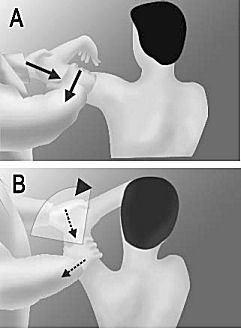Kim test: Difference between revisions
No edit summary |
No edit summary |
||
| Line 2: | Line 2: | ||
'''Original Editor '''- [[User:Sarah McBride|Sarah McBride]] | '''Original Editor '''- [[User:Sarah McBride|Sarah McBride]] | ||
'''Lead Editors''' - Your name will be added here if you are a lead editor on this page. [[Physiopedia:Editors|Read more.]] | '''Lead Editors''' - Your name will be added here if you are a lead editor on this page. [[Physiopedia:Editors|Read more.]] | ||
</div> | </div> | ||
== Purpose<br> == | == Purpose<br> == | ||
Detection of a posteroinferior labral lesion <br> | Detection of a posteroinferior labral lesion <br> | ||
== Technique<br> == | == Technique<br> == | ||
A - With the patient in a sitting position with the arm 90 degrees of abduction, the examiner holds the elbow and lateral aspect of the proximal arm, and a strong axial loading force is applied. | A - With the patient in a sitting position with the arm 90 degrees of abduction, the examiner holds the elbow and lateral aspect of the proximal arm, and a strong axial loading force is applied. | ||
| Line 14: | Line 14: | ||
B - while the arm is elevated 45 degrees diagonally upward, downward and backward force is applied to the proximal arm. A sudden onset of posterior shoulder pain indicates a positive test result, regardless of accompanying posterior clunk of the humeral head. | B - while the arm is elevated 45 degrees diagonally upward, downward and backward force is applied to the proximal arm. A sudden onset of posterior shoulder pain indicates a positive test result, regardless of accompanying posterior clunk of the humeral head. | ||
[[Image:Kim test.jpg|Image:Kim_test.jpg]] | |||
== Evidence == | == Evidence == | ||
| Line 30: | Line 30: | ||
== Recent Related Research (from [http://www.ncbi.nlm.nih.gov/pubmed/ Pubmed]) == | == Recent Related Research (from [http://www.ncbi.nlm.nih.gov/pubmed/ Pubmed]) == | ||
<div class="researchbox"> | <div class="researchbox"> | ||
<rss>http://eutils.ncbi.nlm.nih.gov/entrez/eutils/erss.cgi?rss_guid=1RAka_j-eJMq9m-8tZ4JPSH84HkSJyeolTV7Ihs1wGGUkEuwCQ|charset=UTF-8|short|max=10</rss> | <rss>http://eutils.ncbi.nlm.nih.gov/entrez/eutils/erss.cgi?rss_guid=1RAka_j-eJMq9m-8tZ4JPSH84HkSJyeolTV7Ihs1wGGUkEuwCQ|charset=UTF-8|short|max=10</rss> | ||
</div> | </div> | ||
== References == | == References == | ||
References will automatically be added here, see [[Adding References|adding references tutorial]]. | References will automatically be added here, see [[Adding References|adding references tutorial]]. | ||
<references /> | <references /> | ||
[[Category:Articles]] [[Category:Assessment]] [[Category:EIM_Student_Project_2]] [[Category:Musculoskeletal/Orthopaedics]] [[Category:Shoulder]] [[Category:Special_Tests]] | [[Category:Articles]] [[Category:Assessment]] [[Category:EIM_Student_Project_2]] [[Category:Musculoskeletal/Orthopaedics]] [[Category:Shoulder]] [[Category:Special_Tests]] | ||
Revision as of 17:26, 26 November 2009
Original Editor - Sarah McBride
Lead Editors - Your name will be added here if you are a lead editor on this page. Read more.
Purpose
[edit | edit source]
Detection of a posteroinferior labral lesion
Technique
[edit | edit source]
A - With the patient in a sitting position with the arm 90 degrees of abduction, the examiner holds the elbow and lateral aspect of the proximal arm, and a strong axial loading force is applied.
B - while the arm is elevated 45 degrees diagonally upward, downward and backward force is applied to the proximal arm. A sudden onset of posterior shoulder pain indicates a positive test result, regardless of accompanying posterior clunk of the humeral head.
Evidence[edit | edit source]
The sensitivity of the Kim test was 80%, specificity was 94%. The interexaminer reliability between 2 examiners was 0.91[1].
The accuracy of the jerk test in detecting a posteroinferior labral lesion was the following: sensitivity, 73%; specificity, 98%[1].
The Kim test was more sensitive in detecting a predominantly inferior labral lesion, whereas the jerk test was more sensitive in detecting a predominantly posterior labral lesion. The sensitivity in detecting a posteroinferior labral lesion increased to 97% when the 2 tests were combined[1].
Resources[edit | edit source]
add any relevant resources here
Recent Related Research (from Pubmed)[edit | edit source]
Failed to load RSS feed from http://eutils.ncbi.nlm.nih.gov/entrez/eutils/erss.cgi?rss_guid=1RAka_j-eJMq9m-8tZ4JPSH84HkSJyeolTV7Ihs1wGGUkEuwCQ|charset=UTF-8|short|max=10: Error parsing XML for RSS
References[edit | edit source]
References will automatically be added here, see adding references tutorial.







